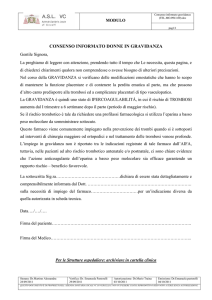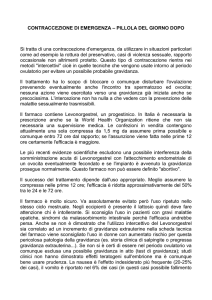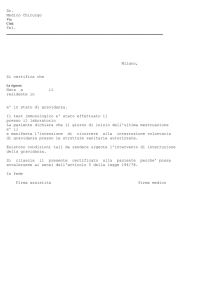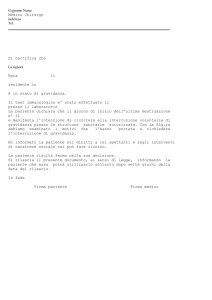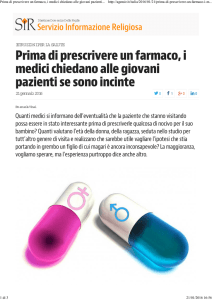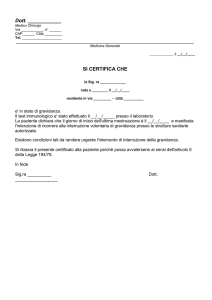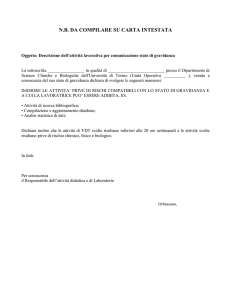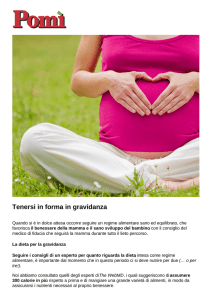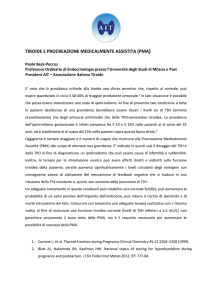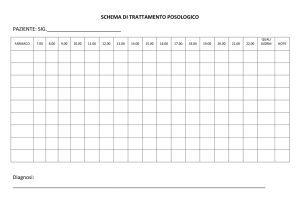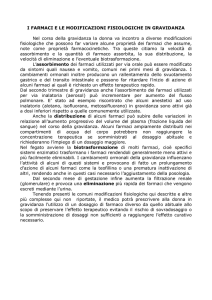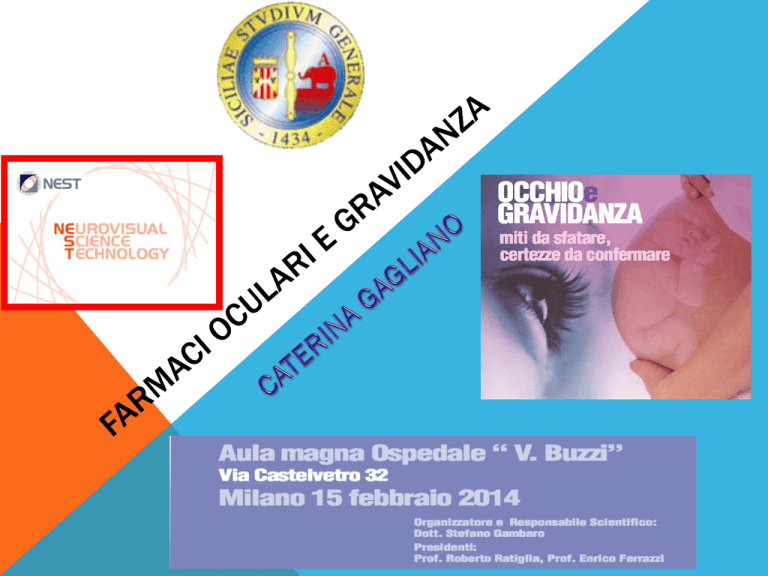
PRIMO TRIMESTRE DI GESTAZIONE
60-90% DI DONNE ASSUME FARMACI
2-3% MALFORMAZIONI CONGENITE
Nepal
J
Ophthalmol.
2012
Jan-Jun;4(1):150-61.
doi:
10.3126/nepjoph.v4i1.5867. Ocular changes in pregnancy. Garg
P, Aggarwal P
Use of ophthalmic drugs can affect fetal health during pregnancy.
VALUTAZIONE DEL RISCHIO DA FARMACI IN GRAVIDANZA
LA VALUTAZIONE DEL RAPPORTO BENEFICIO/RISCHIO DI
UN FARMACO IN GRAVIDANZA È RESA GRAVOSA DA
RILEVANTI PROBLEMI METODOLOGICI ED ETICI CHE
RENDONO DIFFICOLTOSO INDIVIDUARE I COMPOSTI
SICURI E QUELLI PERICOLOSI. QUESTE DIFFICOLTÀ
LASCIANO AMPIO SPAZIO A UNA EMOTIVITÀ OSCILLANTE
FRA ALLARMISMO E SOTTOVALUTAZIONE DEI RISCHI
REALI.
TRATTAMENTI TOPICI OCULARI
- POCA LETTERATURA DISPONIBILE
- NO STUDI CONTROLLATI E RANDOMIZZATI
- RAGIONI ETICHE E LEGALI
- EFFETTI AVVERSI SUL FETO
- PASSAGGIO LATTE MATERNO (0,3% PASSA NEL
LATTE MATERNO)
- EFFETTI AVVERSI SUL NEONATO
Farmaco Instillato
Canale di Schlemm
Area
precorneale
Camera anteriore
Cul de sac
Vasi sanguigni
Kloss
Kabs
Trabecolato
Drenaggio
Legame proteico
Lente
Camera posteriore
Metabolismo
Cornea
Camera
anteriore
Modello di compartimenti oculari per l’assorbimento (Kabs)
e l’eliminazione (Kloss) di un farmaco
Iride, Melanina,
Processi ciliari
(eliminazione)
Le soluzioni oftalmiche rimangono in contatto
con i tessuti oculari solo pochi minuti: 1-5
DESTINO DI UN FARMACO
SOMMINISTRATO PER VIA TOPICA
COLLIRIO
> 95%
ASSORBIMENTO
SISTEMICO
LE PATOLOGIE OCULARI INFLUENZANO LA
BIODISPONIBILITÀ
L’infiammazione accelera la rimozione
dei farmaci dall’occhio
L’aumento delle proteine lacrimali
provoca un calo della biodisponibilità
Alterazioni della struttura della cornea
favoriscono l’assorbimento oculare
Meccanismi di protezione dell’occhio
dalle sostanze chimiche esogene
Lacrimazione;
Drenaggio;
Ammiccamento;
Assorbimento congiuntivale;
Legame alle proteine lacrimali;
Barriera corneale;
Metabolismo.
FATTORI CHE INFLUENZANO LA
BIODISPONIBILITÀ OCULARE DELLA
PILOCARPINA CLORIDRATO IN
SOLUZIONE ACQUOSA.
Fattori di perdita
%
di riduzione
Drenaggio
30,4
Flusso lacrimale normale
22,1
Lacrimazione indotta
16,4
Assorbimento congiuntivale
20,9
Vasodilatazione dovuta alla pilocarpina
3,5
Perdite non-congiuntivali
5,9
Tutti i fattori presenti
99,2
Blood-Ocular Barrier
RPE, retinal pigment epithelium; POS, photoreceptor outer segments; OLM, outer limiting membrane;
ONL, outer nuclear layer; OPL, outer plexiform layer; INL, inner nuclear layer; IPL, inner plexiform layer;
GCL, ganglion cell layer; NFL, nerve fiber layer; ILM, inner limiting membrane
ARTICOLI PUBBLICATI DAL 1975 AL 2014
parole chiave:
- eye drops
- ocular drugs
- pregnancy
- ocular changes
- fetal risk.
QUALI SONO I PRINCIPALI OSTACOLI ALLO
STUDIO DELLA SICUREZZA NELL'USO DI
FARMACI OCULARI IN GRAVIDANZA?
ESPOSIZIONE E VALUTAZIONE DEL RISCHIO
- SEGNALAZIONE DI CASI
- STUDI DI CASISTICA
- STUDI EPIDEMIOLOGICI.
- UNICA FONTE DI INFORMAZIONE SULLA ASSUNZIONE
DI FARMACI DURANTE LA GRAVIDANZA
PAZIENTE STESSA
- ESPOSIZIONE E VALUTAZIONE DELL'ESITO
QUASI IMPOSSIBILE!
SAFEFETUS.COM - MICROMEDEX
Classificazione Food and Drug Administration (FDA)
(categorie A, B, C, D, X)
Categorie di Rischio Fetale.
Farmaci di scelta nelle più frequenti patologie oculari
Farmaci da evitare
CATEGORIA A
STUDI ADEGUATI E BEN CONTROLLATI SU
DONNE IN GRAVIDANZA NON HANNO
DIMOSTRATO RISCHI SUL FETO NEL TERZO
TRIMESTRE E NON C’È EVIDENZA DI RISCHIO
NEGLI ALTRI TRIMESTRI. LA POSSIBILITÀ DI
DANNO FETALE RIMANE REMOTA.
CATEGORIA B
STUDI SU ANIMALI HANNO DIMOSTRATO CHE
NON ESISTONO DANNI EVIDENTI SUL FETO. NON
CI SONO STUDI CONTROLLATI SU DONNE IN
GRAVIDANZA.
CATEGORIA C
STUDI IN ANIMALI HANNO DIMOSTRATO EVENTI
AVVERSI SUL FETO (TERATOGENICITÀ
EMBRIOTOSSICITÀ) E NON ESISTONO STUDI
CONTROLLATI SU DONNE IN GRAVIDANZA. I
FARMACI DOVREBBERO ESSER DATI SOLO SE IL
BENEFICIO POTENZIALE GIUSTIFICA IL RISCHIO
POTENZIALE SUL FETO.
CATEGORIA D
STUDI SU ANIMALI HANNO DIMOSTRATO
EFFETTI AVVERSI E NON ESISTONO STUDI
ADEGUATI E CONTROLLATI SULLA DONNA IN
GRAVIDANZA. ESISTE UN’EVIDENZA POSITIVA DI
RISCHIO FETALE UMANO, MA I BENEFICI
DALL’USO NELLE DONNE GRAVIDE
POTREBBERO ESSERE ACCETTABILI RISPETTO
AL RISCHIO (AD ESEMPIO SE IL FARMACO È
NECESSARIO IN CONDIZIONI DI PERICOLO DI
VITA O PER MALATTIE GRAVI PER LE QUALI
FARMACI PIÙ SICURI NON POSSONO ESSERE
USATI O SONO INEFFICACI)
CATEGORIA X
STUDI ADEGUATI E BEN CONTROLLATI E/O
STUDI OSSERVAZIONALI IN ANIMALI O DONNE
GRAVIDE HANNO DIMOSTRATO RISCHI PER IL
FETO. IL RISCHIO DELL’USO DEL FARMACO IN
GRAVIDANZA CHIARAMENTE SUPERA OGNI
POSSIBILE EFFETTO BENEFICO. IL FARMACO È
CONTROINDICATO IN DONNE GRAVIDE O CHE
POTREBBERO DIVENTARE TALI.
ANTIALLERGICI
- 30% della popolazione allergie (> 50%
manifestazioni oculari). (BARBERÁ E, VÁZQUEZ F.
Tratamientos tópicos oculares: revisión. Inf Ter Sist Nac Salud 2009; 33: 80-87)
- Antistaminici topici: olopatadina,
clorfenamina, emedastina (cat. B)
- Stabilizzatori m. mastociti
- Inibitori della degranulazione:
disodiocromoglicato, nedocromilo,
lodoxamide (cat.B)
An. Sist. Sanit. Navar. 2013; 36 (3): 479-487
ANTIALLERGICI
- 30% della popolazione allergie (> 50%
manifestazioni oculari). (BARBERÁ E, VÁZQUEZ F.
Tratamientos tópicos oculares: revisión. Inf Ter Sist Nac Salud 2009; 33: 80-87)
- Antistaminici topici: olopatadina,
clorfenamina, emedastina (cat. B)
- Stabilizzatori m. mastociti
- Inibitori della degranulazione:
disodiocromoglicato, nedocromilo,
lodoxamide (cat.B)
An. Sist. Sanit. Navar. 2013; 36 (3): 479-487
Ectoina
C?
Lakartidningen. 2009 Jun 24-Jul 7;106(26-27):1746-7.
[Pollen allergy and pregnancy. A literature review of anti-allergic agents shows no increased
risk of fetal injuries]. [Article in Swedish] Björkhem Bergman L, Böttiger Y
ANTIINFIAMMATORI
An. Sist. Sanit. Navar. 2013; 36 (3): 479-487
ANTIBIOTICI
An. Sist. Sanit. Navar. 2013; 36 (3): 479-487
ANTIVIRALI
An. Sist. Sanit. Navar. 2013; 36 (3): 479-487
IPOTENSIVI OCULARI
An. Sist. Sanit. Navar. 2013; 36 (3): 479-487
None of the analyzed studies provide full guarantees of safety for
the fetus. For this reason, it is recommended to suspend medical
treatments in the first quarter of pregnancy when the risk of
fetal malformations is higher.
Arch Soc Esp Oftalmol. 2012 Dec;87(12):389-91. doi: 10.1016/j.oftal.2012.10.005.
[Use of glaucoma medications during pregnancy and breastfeeding].
Méndez-Hernández C
Tutti gli altri farmaci anti-glaucoma (prostaglandine, beta - bloccanti,
inibitori dell’anidrasi carbonica, colinergici) sono in categoria C, ciò
significa che effetti avversi sono stati dimostrati nel feto in studi
animali controllati, di contro non vi sono studi ed evidenze
nell’uomo.
Brimonidina = farmaco più sicuro durante la
gravidanza (cat. B).
Attraversa
la
barriera
ematoencefalica
producendo depressione SNC e apnea nel
neonato
Attraversa la barriera ematoplacentare
Potenziale rischio !!!!
Evitare nel primo trimestre !!!!!!!
Arch Soc Esp Oftalmol. 2012 Dec;87(12):389-91. doi: 10.1016/j.oftal.2012.10.005.
[Use of glaucoma medications during pregnancy and breastfeeding].
Méndez-Hernández C
Farmaci di prima linea nel glaucoma
Analoghi delle PG-F2 esplicano attività ossitocica e
luteolitica = predisposizione all’aborto
Studi sperimentali in animali non hanno dimostrato
effetti sull’embrione anche con dosi 15 volte superiori
alle dosi terapeutiche nell’uomo.
In letteratura l’uso del latanoprost durante la
gravidanza non è stato mai associato a travaglio
prematuro o aborto
Capacità di attraversare la barriera emato-placentare e
di influenzare la motilità oculare.
De Santis M, Lucchese A, Carducci B, Cavalieri A, de Santis L,
Merota A. Latanoprost exposure in pregnancy. Am J Ophthalmol. 2004;138:305–6.
Possono produrre bradicardia e aritmie nel feto.
Per molto tempo ed ancora adesso vengono
usati come antiipertensivi anche in gravidanza
dai ginecologi.
La formulazione in gel con concentrazione più
bassa (0,1%) è l’opzione più sicura.
Si considerano il farmaco di prima scelata in
gravidanza per la maggiore esperienza
nell’utilizzo.
Coleman AL, Mosaed S, Kamal D. Medical therapy
in pregnancy. J Glaucoma. 2005;14:414–6.
Il trattamento orale è stato associato con lo sviluppo
di teratomi sacrococcigei nei neonati.
Non descritti eventi avversi con CAI topici.
È stato recentemente descritto un ritardo della
crescita intrauterina in una donna con glaucoma
congenito che proseguiva il trattamento topico con
una combinazione fissa timololo-dorzolamide in
gravidanza.
DECISION OF FILTRATING SURGERY WITH LOCAL
ANESTHESIA AVOIDING ANTIMETABOLITES
Mendez-Hernandez C, Garcia-Feijoo J, Saenz-Frances F, Santos Bueso E, Martinez-de-laCasa JM, Valverde Megias A, et al. Topical intraocular pressure therapy effects on
pregnancy. Clin Ophthalmol. 2012;6:1629–32.
IPOTENSIVI OCULARI NEL LATTE MATERNO
Il passaggio di questi farmaci nel latte materno è
stato ampiamente dimostrato.
Le stesse opzioni terapeutiche per la gravidanza
possono essere utilizzate nell’allattamento.
Utilizzare timololo in gel come farmaco di prima linea.
Istillare il collirio subito dopo l’allattamento.
Premere sul puntino lacrimale per 5 minuti
immediatamente dopo l’istillazione.
È raccomandata la sospensione dell’allattamento se
è indispensabile il trattamento antiglaucomatoso.
Coleman AL, Mosaed S, Kamal D. Medical therapy
in pregnancy. J Glaucoma. 2005;14:414–6.
ANESTETICI
An. Sist. Sanit. Navar. 2013; 36 (3): 479-487
MIDRIATICI
COLORANTI
An. Sist. Sanit. Navar. 2013; 36 (3): 479-487
SOSTITUTI LACRIMALI
An. Sist. Sanit. Navar. 2013; 36 (3): 479-487
SUPPLEMENTI VITAMINICI
Vitamina K
A
Vitamina D
A
An. Sist. Sanit. Navar. 2013; 36 (3): 479-487
Free Radic Biol Med. 2013 Apr;57:154-61. doi: 10.1016/j.freeradbiomed.2012.12.021. Epub 2013
Jan 4.
Intrauterine exposure to flavonoids modifies antioxidant status at adulthood and decreases
oxidative stress-induced DNA damage.
Vanhees K, van Schooten FJ, van Waalwijk van Doorn-Khosrovani SB, van Helden S, Munnia A,
Peluso M, Briedé JJ, Haenen GR, Godschalk RW.
Author information
Abstract
Maternal intake of flavonoids, known for their antioxidant properties, may affect the offspring's
susceptibility to developing chronic diseases at adult age, especially those related to oxidative
stress, via developmental programming. Therefore, we supplemented female mice with the
flavonoids genistein and quercetin during gestation, to study their effect on the
antioxidant capacity of lung and liver of adult offspring. Maternal intake of quercetin increased
the expression of Nrf2 and Sod2 in fetal liver at gestational day 14.5. At adult age, in utero
exposure to both flavonoids resulted in the increased expression of several enzymatic
antioxidant genes, which was more pronounced in the liver than in the adult lung. Moreover,
prenatal genistein exposure induced the nonenzymatic antioxidant capacity in the adult lung,
partly by increasing glutathione levels. Prenatal exposure to both flavonoids resulted in
significantly lower levels of oxidative stress-induced DNA damage in liver only. Our observations
lead to the hypothesis that a preemptive trigger of the antioxidant defense system in utero had
a persistent effect on antioxidant capacity and as a result decreased oxidative stress-induced
DNA damage in the liver
Can J Clin Pharmacol. 2006 Fall;13(3):e262-7. Epub 2006 Nov 3.
Safety and efficacy of echinacea (Echinacea angustafolia, e. purpurea and e. pallida)
during pregnancy and lactation.
Perri D, Dugoua JJ, Mills E, Koren G.
Author information
Abstract
BACKGROUND:
There is a lack of basic knowledge on the part of both clinicians and patients as to the indications for use and
safety of herbal medicines used in pregnancy and lactation. This is one article in a series that systematically
reviews the evidence for commonly used herbs during pregnancy and lactation.
OBJECTIVES:
To systematically review the literature for evidence on the use, safety, and pharmacology of echinacea focusing
on issues pertaining to pregnancy and lactation.
METHODS:
We searched 7 electronic databases and compiled data according to the grade of evidence found.
RESULTS:
There is good scientific evidence from a prospective cohort study that oral consumption of echinacea during the
first trimester does not increase the risk for major malformations. Low-level evidence based on expert
opinion shows that oral consumption of echinacea in recommended doses is safe for use during pregnancy
and lactation.
CONCLUSIONS:
Echinacea is non-teratogenic when used during pregnancy. Caution with using Echinacea during lactation until
further high quality human studies can determine its safety.
Vitamin D, Vitamin A, Maternal-Perinatal
Considerations: Old Concepts, New Insights, New
Questions
Teresa Murguıa-Peniche, MD
Vitamins A and D are essential nutrients that play important roles in
growth and development. Preterm and low birth weight infants
have low levels of these nutrients and are at risk for developing
detrimental health consequences associated with vitamin A and
vitamin D deficiencies. Preliminary data suggest that vitamin A
and D supplementation is needed to prevent deficiency. More
work is needed to define optimal doses, timing, and modes of
adminis- tration to ensure that an adequate supply of these
vitamins is available to meet the critical needs during pregnancy
and in high-risk neonates. (J Pediatr 2013;162:S26-30).
FARMACI INTRAVITREALI
An. Sist. Sanit. Navar. 2013; 36 (3): 479-487
Prescrire Int. 2012 Mar;21(125):66.
Ranibizumab and diabetic macular oedema: after laser therapy
Ranibizumab can cause birth defects, even
after intravitreal injection during pregnancy.
TOSSINA BOTULINICA
An. Sist. Sanit. Navar. 2013; 36 (3): 479-487
Am J Clin Nutr. 2012 Nov;96(5):1204S-6S. 2012
Oct 10.
A global clinical view on vitamin A and
carotenoids.
Sommer A, Vyas KS.
The clinical importance of vitamin A as an essential
nutrient has become increasingly clear. Adequate
vitamin A is required for normal organogenesis,
immune competence, tissue differentiation, and the
visual cycle.
Int J Vitam Nutr Res. 2012 Oct;82(5):342-7. doi:
10.1024/0300-9831/a000129.
Vitamins for the first 1000 days: preparing for life.
Elmadfa I, Meyer AL.
Abstract
Vitamins are essential nutrients for many body functions
and particularly important during growth. Adequate supply
in pregnancy and in early infancy is therefore crucial, but
there is still a lack of knowledge about the needed
amounts of vitamins of children older than six months and
also during pregnancy.

